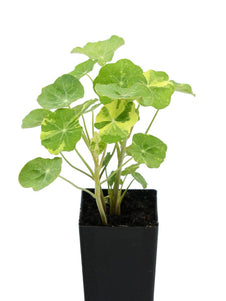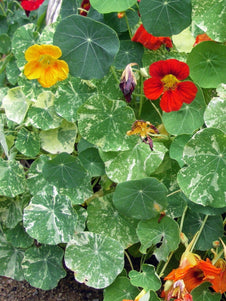





Nasturtium Alaska
Nasturtium Alaska

- In stock, ready to ship
- Inventory on the way

Usually available: March to December
Life cycle: Annual
Height: 50cm - 1.5m
Position: Sun / part shade
Soil preference: Well drained
This is how we pack and send your Herb Plants to all states except TAS & WA
You will receive
- 1 Nasturtium Alaska Herb Plant in a 50 X 75mm tube - General growing instructions
All of our Herb Plants are grown organically with certified organic potting mixes and fertilizers
Botanical Name: Tropaeolum majus
The common garden nasturtium is an herbaceous perennial, with a trailing habit up to 1 or 2 meters. It is more often treated as an annual due to local conditions and is a highly ornamental plant. The flowers are a bright orange to red, or yellow toned with a slight frill. Some cultivated varieties are more frilled, may be variegated or have a slight fragrance. The flowers are large, 2-6cm in diameter and face outwards or sideways, rather than up to the sky. The flower is characterised by the long nectar spur, extending down and back about 2-3 cm. The flower has 5 petals, which may be slightly ruffled, and 8 stamens.
The whole plant is lush and quite fleshy, with a tropical appearance. The large mid to dark green leaves are lighter underneath and may grow to 3-15cm in diameter, saucer sized! The young leaves start out indented and then fill out to round or slightly lobed, smooth edges. When it rains, water droplets collect on the surface and roll around as the leaf moves. The leaves are peltate, with the stem extending from the leaf centre and veins radiating out across the round leaf.
The native environment of nasturtium is South America, specifically the mountain slopes of the Peruvian Andes and from Bolivia to Colombia. The genus Tropaeolum was named for the phrase ‘little trophy’ or ‘trophy pole,’ because the leaves were similar to shields and the flowers represented bloodied helmets.
Common nasturtium is not related to the watercress in the genus Nasturtium, but was named for similarities in taste. The word nasturtium means ‘nose twister’ or ‘nose tweaker’. It is also called monks cress or Indian cress, because South America was known as ‘the Indies’ in earlier times.
The nasturtium is very ornamental and treated this way by most gardeners. However, there is a history of both culinary and medicinal use, now moderated by safety concerns, particularly for children, pregnant women and sufferers of certain health conditions.
Growing Conditions
Nasturtiums are grown as a cool season annual in cool, warm and tropical areas of Australia. They prefer full sun, and become ‘leggy’ where it trails into the shade. Dwarf varieties may tolerate shade more than the large garden nasturtium. The plant will trail over other plants or along the ground, but the fleshy, soft stems can easily be trimmed if necessary.
There are varying reports of soil requirements for optimum nasturtium growth. Some experts recommend a rich organic soil, well drained, but with moist conditions. Others suggest that average, free draining, sandy soil, with less organic matter is quite suitable. Nasturtiums are very hardy and easy to grow, so it is likely that they will do well in either situation. Less fertiliser or organic matter results in more flowers and seeds, while extra fertilising will lead to more leaf production. Once they are established, there is only moderate watering required, although extreme heat may lead to wilted leaves.
Flowers appear in spring and continue through the summer until conditions become too dry. Some will produce many flowers, but later in the season, usually after pollination, the plants begin to wilt and die. Once pollinated the flower petals drop off and the stem droops to the ground, hidden under remaining leaves. Seeds then drop straight into the ground in readiness for the next growing season. The natural pollinators for nasturtiums are hummingbirds, but bees do a reliable job here in Australia!
Nasturtium grows well in containers and this may be a good option for growing in areas susceptible to frost or cool conditions. A trellis can be placed behind the pot and the plant can trail upwards giving you some control over the spread. This may also alleviate problems with the plant spreading too far and control the location of seed drop.
Propagation is by seed, sown directly 2cm deep in clumps, remembering that they will trail to fill the area. Dwarf varieties will tend to clump rather than trail, so they can be sown or planted 40cm apart. The main roots are fleshy and stems covered with soil may develop adventitious roots. Nasturtiums left to self seed will reappear regularly each year after the first rainfall. After several generations, you may notice hybrid flowers colours appear amongst your regular orange flowers.
The fresh leaves and flowers can be harvested any time and used as needed. They don’t keep well, but the leaves can be wrapped in plastic and frozen for 6 months. The buds and seeds can be preserved in vinegar.
Culinary Uses
Used in moderation, all parts of the nasturtium are edible and have the characteristic peppery taste. The leaves and flowers can be used in salads and the flowers add a nice bright garnish to dishes. The buds and seeds can be pickled in vinegars and can also be used as caper substitutes. The large leaves can be used as wraps for food, such as shredded salads and rice salads.
Medicinal Uses
Most people use nasturtium as an ornamental plant, but historically it has shown benefit in antibacterial and antifungal capacities. It has been used in acne treatments with some success, but a specific approach is required for success. Since the 1950’s, nasturtium has been used for treatment of urinary and respiratory infections. It should be noted that the nasturtium acts only on the organs that deal with water and air – lungs, kidney and bladder.
Exercise caution with high doses because nasturtium contains mustard oil, derived from benzyl isothiocyanate, which can irritate mucosal membranes in some people. Avoid giving it to young children, pregnant women and people with kidney or gastrointestinal problems, due to potential mucosal damage and side effects.
Companion Plants
Nasturtium is highly valued for its companion planting benefits. It will repel a number of insects, specifically cucumber beetle and several caterpillars, and attract beneficial predatory insects. Nasturtium benefits the brassicas by acting as a food source for the larvae of the white cabbage moth, therefore drawing them away from your vegetables. It also attracts a type of aphid and is loved by slugs and snails, so it helps to protect other vegetables in this way.
Nasturtium is a good companion to cabbages, cauliflowers, broccoli and radishes. It is reputed to improve the flavour of vegetables and fruit trees when planted nearby.
All information provided on this website is for informational purposes only. Please seek professional advice before commencing any treatment.





